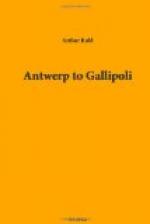It had all been fought over at least twice—railroad stations and farm buildings burned, bridges dynamited, telegraph-poles cut down. The stations now were mere board shelters for a commandant and a soldiers’ lunch-room; the bridges, timber bridges flung across by the pioneers; and the sawed-off telegraph-poles, spliced between railroad rails to save cutting new ones, were stuck back into the ground like forks. The Russians had a rather odd way of burning stations and leaving the rails, the important thing, intact, but here and there they had neatly destroyed them for miles by exploding a cartridge under the end of each.
The country is level here—fields interspersed with dark pine forests, planted in the European fashion, to be grown and harvested like any other crop—parks of living telephone-posts, thick as the quills of a porcupine. And through these pines and across the fields were the eternal Russian trenches, carefully built, timber-lined, sometimes roofed and sodded over, with rifle holes under the eaves. Barbed-wire entanglements, seven rows deep sometimes, trailed in front of them, through timber, through the long grass and flowers of marsh-land, a wicked foggy band against the green as far as one could see. Along the Galician front and in the Carpathians I had seen mile after mile of such trenches, timber-work, wires, and Spanish riders left behind, good as new, until it began to seem as if war were a peculiarly absurd game, consisting principally in chopping down good trees and digging ditches, and then going somewhere else.
In front of Ivangorod great preparations had been made. There was no town here, but the great fortress, with its citadel, barracks, machine-shops, gardens, church, and protecting forts, was almost a city in itself. It had a garrison of twenty thousand, and its gigantic concrete walls, covered over with earth and grass, its, moat and barbed wire, looked formidable enough. It had no modern heavy artillery, however, and even if it had, artillery in a fixed, known spot is comparatively helpless against the mobile guns, screened by hills and timber, besiegers can bring against it. Elaborate earthworks had, therefore, been thrown up several miles to the west of the fortress, but these became useless when the enemy, crossing the Vistula to north and south, swung round to cut off the one way out—the railroad to Brest-Litovsk.
The Russians might have shut themselves in and waited—not very long, probably—until the big “thirty-point-fives” smashed the fort to pieces. They chose to get out in time, blew up the railroad bridge across the Bug, burned the barracks, and, with enough dynamite to give a good imitation of an earthquake, tumbled the walls and galleries of the fortress into melancholy heaps of rock.
It was dusk when we rolled into Ivangorod and into the thick of that vast and complicated labor which goes on in the rear of an advancing army—all that laborious building up which follows the retreating army’s orgy of tearing down—bridge builders, an acre or two of transport horses, blacksmiths and iron-workers, a semi-permanent bakery, the ovens, on wheels, like thrashing-machine engines, dropping sparks and sending out a sweet, warm, steamy smell of corn and wheat. It never stopped, this bakery, night or day, and the bread was piled up in a big tent near by like cord-wood.




